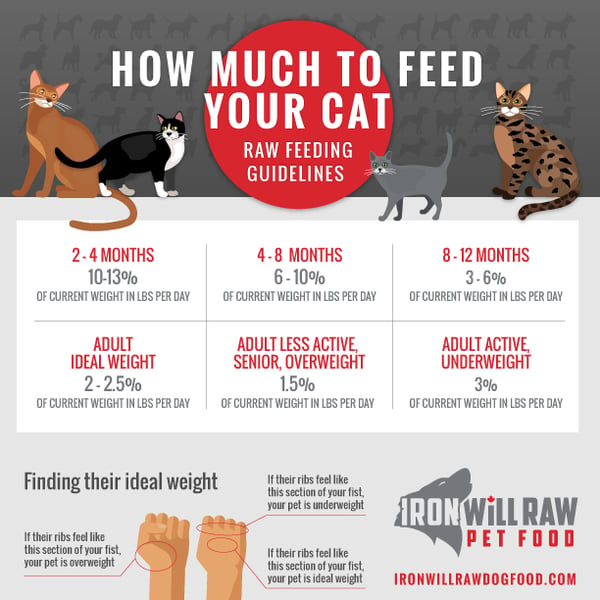Just like dogs, cats have their own ways of letting you know they are hungry. They may climb on you, meow in your face, paw at you, or even follow you around.
However, cats require different portions than their larger canine friends.
Cats are significantly smaller than most dogs- with some exceptions, of course. Here’s what you need to consider when you are making the switch to raw food.
THE TRICKY THING ABOUT CATS
There are a few factors to consider about your specific feline friend when it comes to feeding them a raw diet.
Sometimes transitioning your cat to a raw food diet means getting them to adjust to a different type of feeding schedule than they are used to. Some cats graze at their bowls casually throughout the day, while others will try to gobble down the entire bowl. When transitioning to raw it’s best if you can start to get your cat acclimated to meal feedings by reducing the all day buffet.
Outdoor cats vs. indoor cats is also a factor. Outdoor cats tend to get more exercise, running around all day playing in the fresh air. Indoor cats can be active, too, but this difference should be factored in when you determine their portions.
Then there’s the difference between breeds. For example, a Maine Coon or Savannah are some of the largest breeds, sometimes growing to be up to 1 metre long. However, they can take several years to fully physically develop, which means they are still growing when most cats have stopped. This difference in growth rate will alter their dietary needs.
IDEAL FOOD PORTIONS FOR KITTENS
Anyone who has ever owned a kitten before knows how rambunctious and curious they are. They need more food than adult cats so they can fuel their thirst for adventure.
Kittens can’t eat as much as adult cats at one time, so you may want to consider feeding them smaller meals more often instead of a few larger meals. They need all of the nutrients they can get to maintain their energy levels and keep up with their daily activities.
Here is a general guide for feeding raw food to your kitten:
- 2-4 months old: 10%-13% of their current body weight (in pounds) per day
- 4-8 months old: 6%-10% of their current body weight (in pounds) per day
- 8-12 months old: 3%-6% of their current body weight (in pounds) per day
HOW MUCH TO FEED ADULT CATS
As they become adults, cats’ metabolism tends to slow down. You may notice that your cat is spending more time napping in the sun, only getting up to eat and occasionally play. Some cats may retain their energy, but others tend to turn into sun-spot chasers as they get older.
Here is a general guide for feeding adult cats:
- Cats at their ideal weight: 2%-2.5% of their current body weight (in pounds) per day
- Less active, senior, overweight cats: 1.5% of their current body weight (in pounds) per day
- Active, underweight cats: 3% of their current body weight (in pounds) per day

GET EXPERT ADVICE FOR YOUR FELINE FRIEND
If you aren’t sure about your own cat, we’re here to help. Contact us if you need any extra help or advice making sure your cat gets the nutrients she needs to live her best life, no matter how she spends her days.

